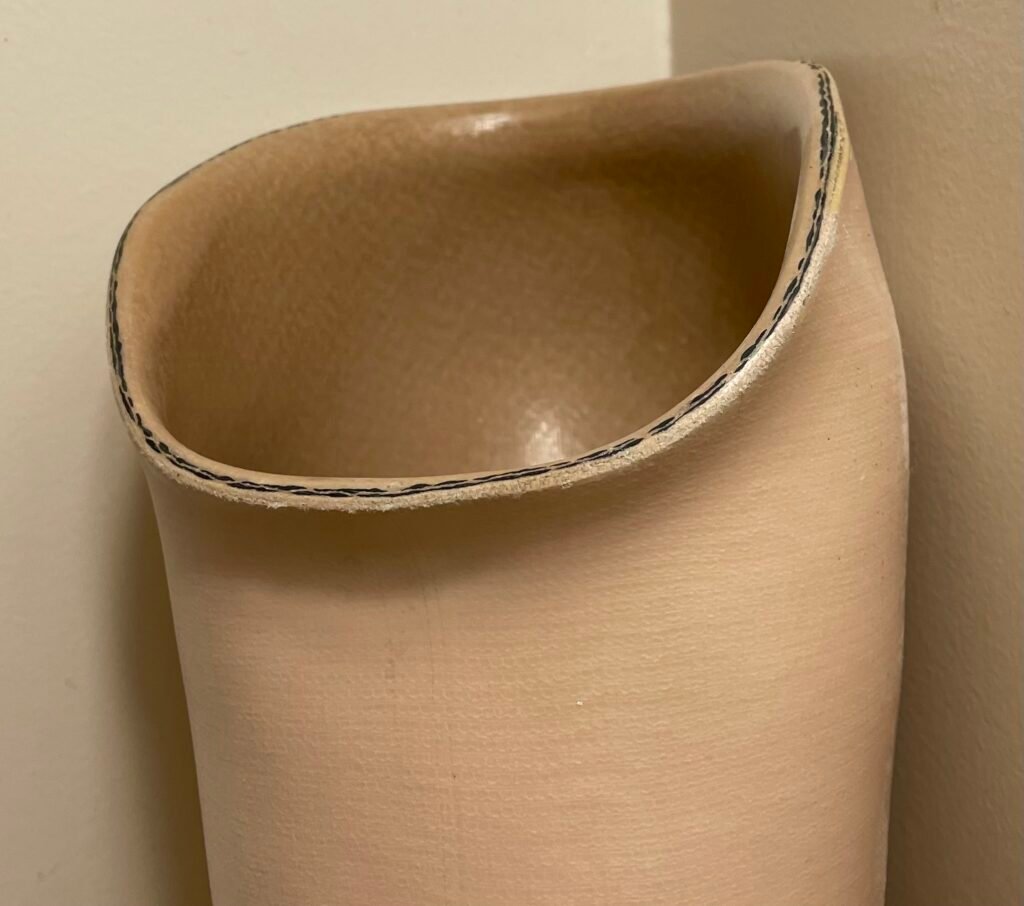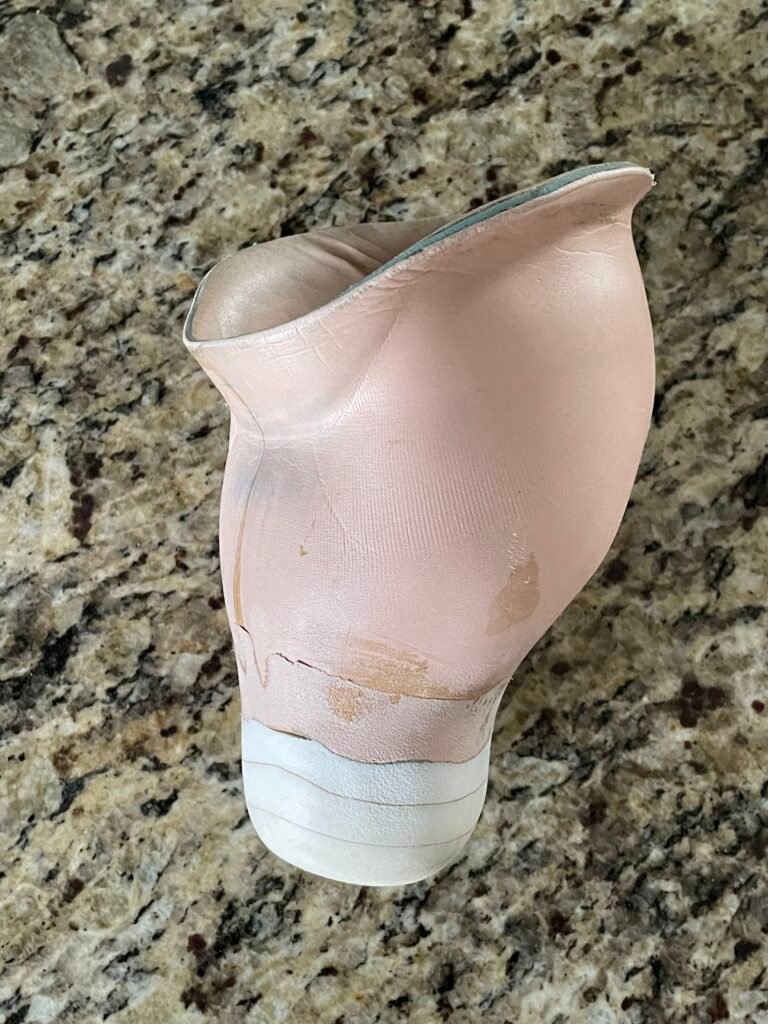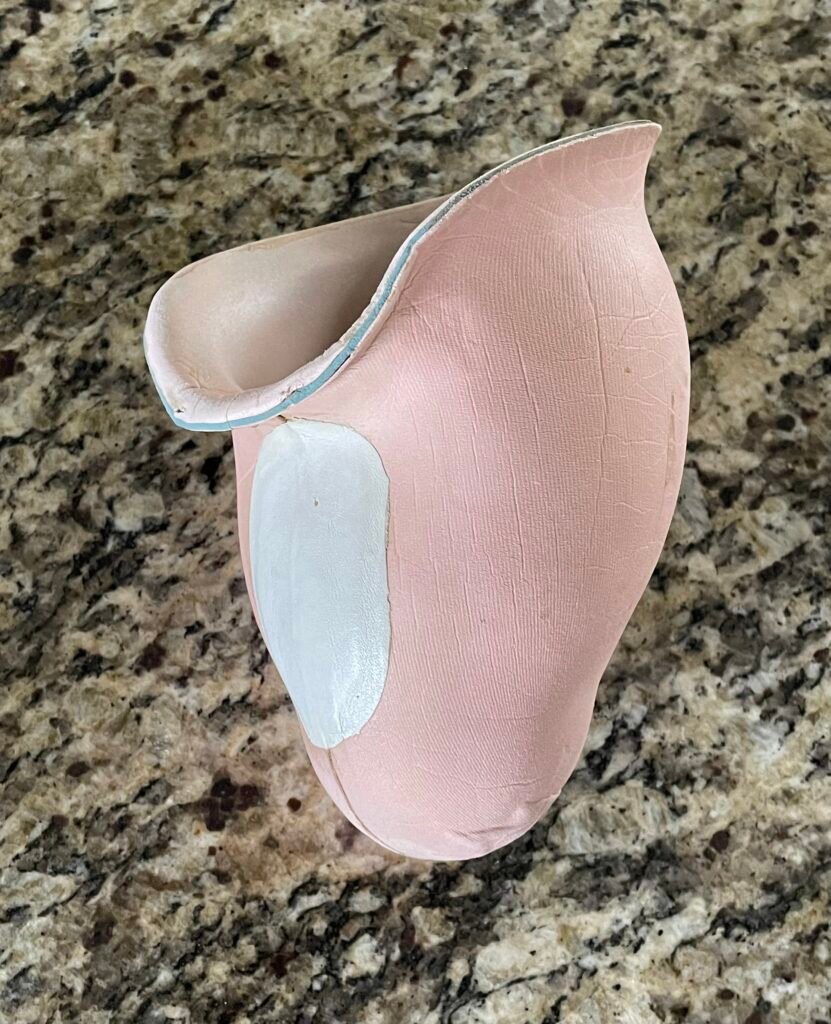Socket design & Fitting –
Now, let’s get to it. Socket design and impression (aka casting) is the starting point of making a prosthesis. It is the most important step and most difficult for BK-Short. First, an impression of your residual along with the knee is needed in order to create a mold. The impression can be done by casting or by using a scanning technology. Then an identical mold is created and the prosthetist can make adjustments to the mold, applying pressure to the right areas that carry the weight and relieve pressures off sensitive areas that cannot tolerate the weight. After the mold is created and adjusted, a socket and a liner can be made using this mold.
BK-Short will need to look for a prosthetist with special experience and talent in fitting, especially with shorter residuals. Once you find a prosthetist, you can either give them a chance to show you what they can do for you, or show them what you would like to have done. In any case, looking at pictures below, you will notice that unlike the standard prosthesis socket, you need a higher top that covers the entire knee area, a higher back with a shallow opening, and a narrower opening at the top. This high top design will allow BK-Short to compensate for the short residual by increasing the leveraging size of the residual, so that you can operate the leg more successfully. Otherwise, a thigh corset will be needed. The high back design will prevent your residual from coming off the back when you bend your knee. Do not use a low back design, it will not work and can cause injury when your short residual slips off the back. Also, the narrow opening is necessary to help your short residual keep a good grip on the prosthesis, so it does not easily slip off.
While this design is optimum for BK-Short, as it should fit like a glove, it has two minor drawbacks. First, while the narrow opening helps keep the prosthesis on, it takes slight twisting as you get into the prosthesis. But this drawback beats having a suspension belt that keeps the prosthesis from coming off. A suspension belt would be screwed to the socket and run from the prosthesis up your thigh and around your waist. I have used them before, and they are not fun. Second, the high-back socket will allow the knee to bend comfortably up to around 45 degrees and will begin resisting a knee bend beyond 45 degrees. Again, this drawback easily beats your residuals coming off a low-back opening, which can be painful or cause injury. I was happy to live with these two minor drawbacks for 45 years, given the benefits.


Liner Design & Materials –
Like the socket, the liner is also built using the mold. So, the liner design and shape will follow the contour of the socket design, with an extra half inch overhang at the top (see pictures below). However, there are a couple of essential improvements to be made. First, your choice of materials is important, as there are many. I tend to like the Tri-lamination. Tri-lamination sandwiches a cushiony, soft but brittle PPT foam between two flexible and durable Pelite foams, thus creating a comfortable and durable combination. Tri-lamination can be specially made or come pre-made. Second, at the bottom of the liner, you need to create a 1-2 inch stump extension (see pictures below with and without extension). This is key, and the second most important adaptation (after high-top, high-back, and narrow socket opening). This is essentially what is needed to avoid the stump extension medical surgery. This can be done by adding layers of foam on the bottom of the liner, thus simulating a longer residual. For slight improvement in suspension, it is better to use a hard gel pad on the bottom of the liner, at the core of this 1-2 inch stump extension. Then, build the foam around it. Obviously, during the design and creation of the socket and liner, your prosthetist will allow the precise room in the socket for the stump extension that is added to the bottom of the liner, for a perfect fit.


When making a liner, make sure that you ask for 2 separate liners that are made the same way. Why? While they are made identical, they will have slight pressure point differences, and this slight difference will allow your residual skin to get some relief, as you alternate between them. Also, during your first testing of socket and liner at the prosthetic facility, you should heat the newly completed liner(s) from the inside with a hot blow gun. Then, immediately wear your liner and step in the socket with your weight, and stand in for a few minutes. This will allow the liner to mold perfectly with your residual and socket. Make sure that you have a heat barrier over your skin (for protection), along with proper socks, as described below. Also, make sure that you have a light sheath-like sock over the liner itself, for better friction between the liner and socket. Whatever you do, do not throw these liners in the washer or the dryer, they will be ruined.
Another liner option is gel liners. They are great for most amputees with longer residuals, as they come in varieties and provide great comfort. However, gel liners are usually not good for most BK-Short, because gel reduces the precision of fitting and motion. Meaning, the high top, high back, narrow fitting socket is done to increase your leverage and improve the precision of fitting and grip. Using gel liners will reduce this precision of fitting and grip, and the gel will feel sloppy. Gel liners also will not allow the creation of the stump extension. But, you can try it if you like, it might work for you as I did, perhaps as a second or swimming prosthesis.
Please note that over the years, I have been told by several prosthetists to be patient with painful fitting until the skin gets tougher, or scar tissues develop, etc. This is absolutely false, and I can tell you that I have not walked in a painful prosthesis since my first two that did not work 45 years ago. Yes, sometimes you are in discomfort because your residual is irritated, or you have developed sores, which you should let heal or use Dr. Scholl’s donuts or similar as described below. But if you are walking in a painful prosthesis that has a bad socket and liner design or fitting, you should get this corrected right away, as the pain will severely limit your activity and sores will develop rapidly. Also, be aware that some prosthetists, with less casting and fitting experience, will direct you to use gel liners to hide their lack of experience with precision casting and fitting.
Note: Amputees with short residuals should avoid gel liners with pins. If you happen to slip and fall, you will have much less severe injury if the prosthesis slips off than if the pin keeps it on. Also, when you lose weight in your residuals and your stump sinks deeper, the bottom of your stump will rub against that pin, thus causing much pain.
